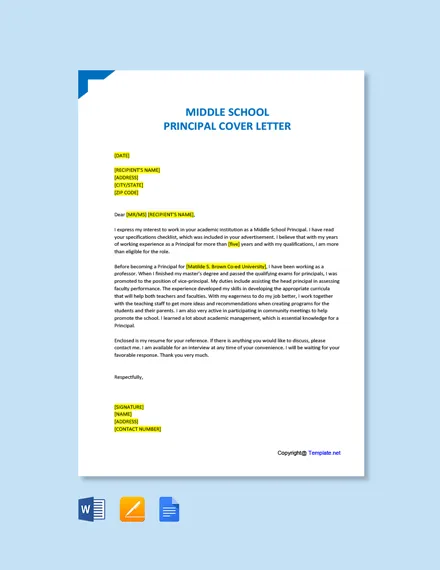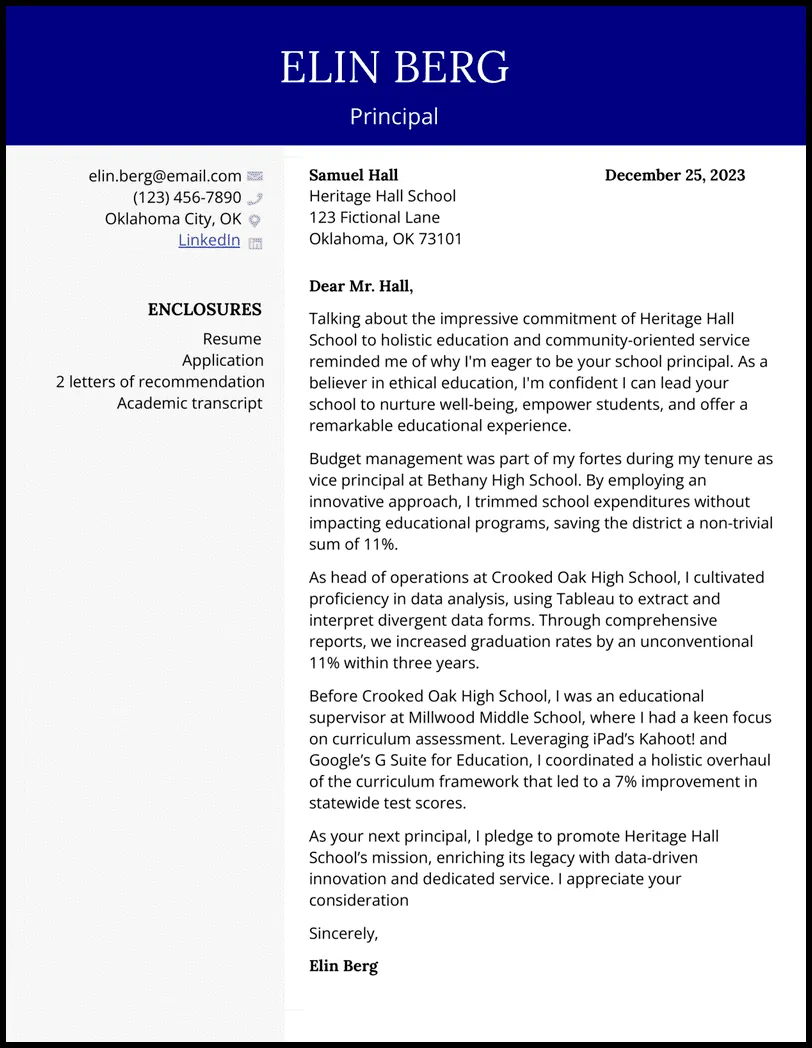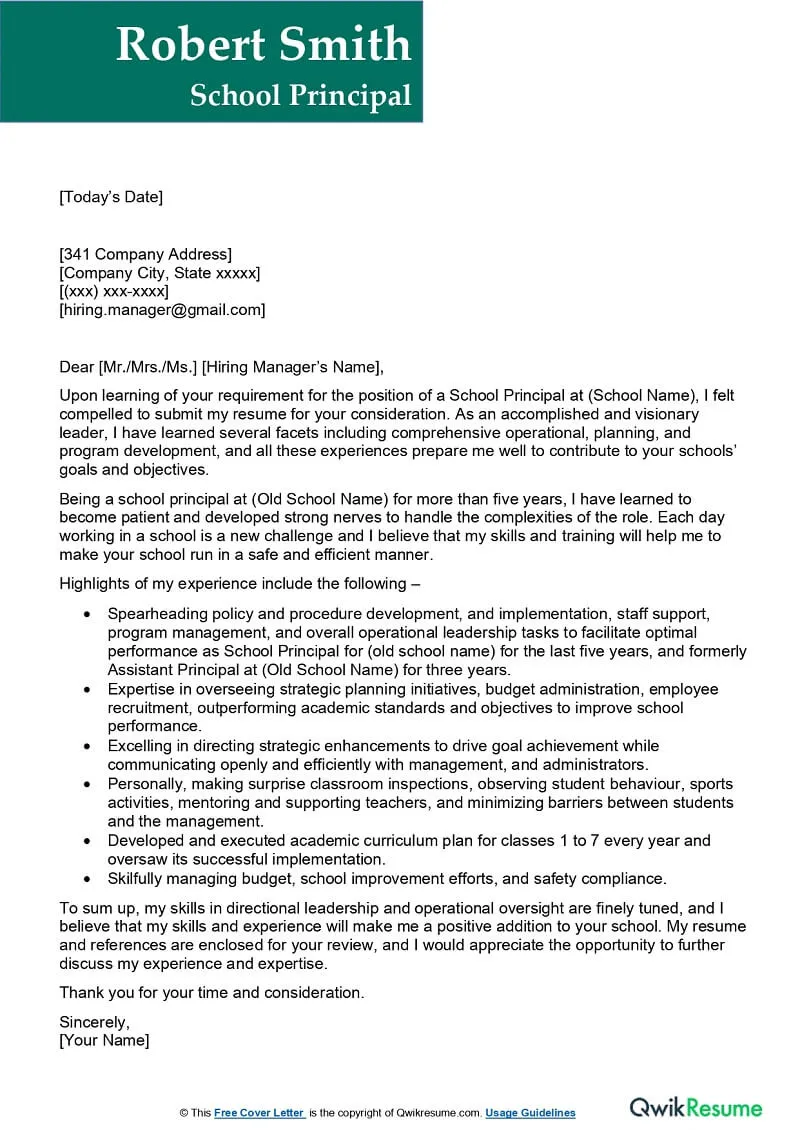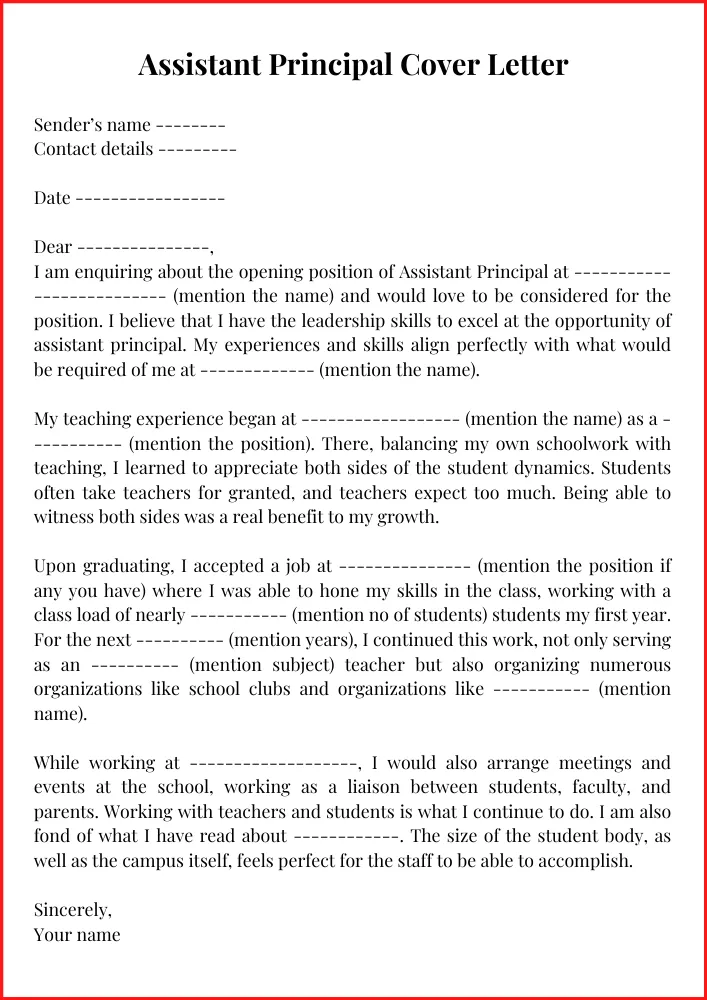Crafting Your Principal Cover Letter
A well-crafted principal cover letter is your first impression, the critical bridge between your resume and the school board’s decision-making process. It’s not just a formality; it’s your chance to showcase why you are the ideal candidate for the role. Your cover letter provides the space to explain your qualifications, leadership experience, and educational philosophy in a way a resume cannot. This guide offers a step-by-step approach to create a cover letter that effectively communicates your value and helps you land your dream job as a school principal.
Understanding the Purpose of a Principal Cover Letter
The primary purpose of a principal cover letter is to introduce yourself and make a case for your candidacy beyond the basic information provided in your resume. It’s an opportunity to highlight your unique skills, experiences, and leadership qualities relevant to the specific school and its needs. It should demonstrate your understanding of the role, your passion for education, and your ability to make a positive impact on the school community. This initial communication is crucial to persuade the hiring committee to review your resume and invite you for an interview.
Highlighting Your Leadership Experience

Leadership is at the core of a principal’s responsibilities. When crafting your cover letter, it’s essential to highlight your leadership experience and skills. This involves describing your past roles, the challenges you faced, and the strategies you employed to overcome them. Focus on examples that demonstrate your ability to inspire and motivate staff, build a positive school culture, and effectively manage school operations. Show how you have fostered collaboration, improved student outcomes, and supported teacher development. The goal is to show how your leadership style fits with the school’s needs.
A successful principal understands how to lead with vision. Your cover letter should clearly communicate your vision for the school’s future. Detail your ability to develop and implement strategic plans. Explain how you have set goals, assessed progress, and made data-driven decisions to improve the educational environment. This also includes your familiarity with curriculum development, assessment practices, and the ability to create a stimulating and inclusive learning environment.
Quantifying Your Achievements
Simply stating that you are a good leader isn’t enough; you must provide concrete evidence of your accomplishments. Quantifying your achievements makes your cover letter more impactful and credible. Use data and statistics to illustrate your successes. Instead of saying “Improved student test scores,” state “Increased student test scores by 15% within two years through the implementation of a new literacy program.”
Quantify your achievements by using data. You could also mention how you managed budgets, increased parent involvement, reduced disciplinary issues, or improved teacher retention rates. Provide specific examples of the positive impact you had in your previous roles. Highlighting specific achievements with supporting metrics gives the reader an idea of the positive outcomes you can bring to their school. This showcases your ability to set goals and attain them effectively.
Showcasing Your Educational Philosophy
Your educational philosophy is a critical element of your cover letter. This section allows you to articulate your beliefs about education and how you plan to create a positive and effective learning environment. Outline your core values, your approach to student success, and your commitment to inclusive practices. Demonstrate how you integrate innovative methods, promote social-emotional learning, and support the overall well-being of students and staff.
In your cover letter, clearly articulate your commitment to the school’s mission and vision. Demonstrate how your educational philosophy aligns with the school’s goals and values. If the school values diversity, equity, and inclusion, make sure to emphasize your dedication to these principles. This demonstrates that you are a good fit for the school.
Demonstrating Knowledge of School Administration

A principal must have a deep understanding of school administration. Your cover letter is the place to demonstrate your knowledge of curriculum, assessment, budgeting, and school policies. Highlight your experience in creating and managing budgets, ensuring compliance with legal and regulatory requirements, and fostering effective communication with all stakeholders. Also, outline your proficiency with school management systems, data analysis, and your ability to use technology to enhance the learning experience.
Furthermore, highlight your experience in dealing with the unique challenges of school administration. This may include your experience in conflict resolution, crisis management, and the development of effective safety protocols. Include your awareness of current educational trends, your ability to implement evidence-based practices, and your commitment to continuous improvement.
Including Essential Cover Letter Sections
A well-structured cover letter consists of a few critical sections to maximize its impact. First, a professional header with your contact information. This includes your name, phone number, email address, and professional online profiles (if you have them). Then, the introduction, which quickly states the position you’re applying for and where you saw the job posting. Next, the body, where you present your experience, accomplishments, and relevant skills.
The conclusion is a summary of why you are the perfect fit, reiterating your interest and asking for an interview. Ensure you include the name of the hiring manager if possible. Make it a practice to tailor your cover letter and resume to each job to increase your chances of success. It is important to proofread everything, before submitting the application.
Writing a Strong Opening Paragraph
Your opening paragraph is your first and possibly only chance to grab the reader’s attention. Start with a strong statement that directly addresses the school’s needs and conveys your enthusiasm. The tone should be engaging and professional. Immediately state the position you are applying for and how you found the job posting. Briefly mention a key achievement or skill that sets you apart and highlights your interest in the specific school.
If you know someone at the school or have had prior interactions with the institution, this is the place to mention it briefly. Doing this provides an immediate connection and shows your familiarity with the school. Always keep the focus on what you can bring to the school and why you are excited about the opportunity.
Describing Your Relevant Experiences

In the body of your cover letter, explain your relevant experiences by providing specific examples that demonstrate your leadership skills, management abilities, and educational philosophy. Use the STAR method: Situation, Task, Action, and Result. Start by describing the situation. Explain the context and the challenges you faced. What task was required of you? Then detail the specific actions you took to address the situation.
Finally, show the positive results achieved. For example, when describing a previous role, outline your responsibility, the actions you took, and the outcomes. Including quantified achievements makes your accomplishments more credible. Make sure to use action verbs to start your sentences to strengthen the impact of your experience.
Highlighting Leadership Skills
Highlighting your leadership skills is essential. Show how you have inspired and motivated staff. Explain how you built a positive school culture. This could include creating professional development opportunities, implementing mentorship programs, or establishing clear communication channels. If you have experience in conflict resolution or mediation, be sure to mention this.
Outline your ability to build consensus, manage school operations efficiently, and make data-driven decisions. Show how you have improved student outcomes and fostered a collaborative environment. Emphasize that you can promote innovation and support change within the school. Providing specific examples adds credibility to your claims.
Showcasing Your Educational Philosophy
Showcasing your educational philosophy involves clearly articulating your core beliefs about education and how you will lead the school. You can also show your commitment to a student-centered approach, emphasizing the importance of creating a stimulating and inclusive learning environment. Also, discuss your views on how to engage with and support teachers.
Emphasize your dedication to promoting diversity, equity, and inclusion. Detail how your philosophy aligns with the school’s mission and vision. Providing specific examples demonstrates how you translate your beliefs into practical actions. Including this information makes you more attractive to the hiring committee.
Mentioning Achievements & Results

Mentioning achievements is an important part of your cover letter to show that you are capable of succeeding in the role. Use data and metrics to illustrate your accomplishments. Did you improve student test scores? Did you increase parent involvement? Did you secure grant funding? The details make your statements more credible and show that you can deliver results.
When describing your accomplishments, use the STAR method. This will help you describe the situation, your tasks, the actions you took, and the results. This format will help you give a comprehensive account of how you have made an impact. Highlighting specific outcomes with measurable results makes your cover letter more compelling. It is important to focus on the skills the school board wants, by looking over the requirements in the job description.
Writing a Compelling Closing Paragraph
Your closing paragraph should summarize your qualifications and restate your enthusiasm for the position. Reiterate your interest in the school and your commitment to its mission. Express gratitude for the hiring committee’s time and consideration. Clearly state your desire for an interview and provide your contact information once again. Proofread your cover letter again to make sure that everything is easy to read and grammatically correct. The closing is a chance to make a strong final impression.
A strong closing paragraph motivates the reader to take action. Your closing must leave a positive and lasting impression. If possible, tailor your closing to reference something specific about the school or its values. By reinforcing the connection between your skills and the school’s needs, you are more likely to get an interview.
Formatting Your Principal Cover Letter
Proper formatting is key to ensuring your cover letter looks professional and is easy to read. Your cover letter must be clean, organized, and easy on the eyes. Choose a standard font, use appropriate spacing, and maintain consistent formatting throughout the document. It’s all about creating a professional appearance.
Ensure your contact information is clearly displayed at the top. Use standard margins (1 inch on all sides) and single-space the body of the letter. Add a professional header with your name, phone number, email, and other relevant information. Use proper grammar and formatting to improve the readability of your letter. When formatting a cover letter, you want to emphasize professionalism and attention to detail.
Choosing the Right Font & Size

Select a professional and easy-to-read font for your cover letter. Common choices include Times New Roman, Arial, or Calibri. The ideal font size is between 11 and 12 points. Ensure the font size and style are easy to read. Avoid using overly stylized or decorative fonts, as they can distract from the content and make your letter look unprofessional. It’s better to keep it simple.
Maintain consistency with your chosen font and size throughout the document. This is a way to create a polished and cohesive look. Before submitting your cover letter, make sure it is easy to read. Make sure the font choice and size are appropriate for the length of your letter. Choose a font that looks good on both screen and print.
Proper Formatting & Layout
Use appropriate spacing and layout to enhance the readability of your cover letter. Use standard one-inch margins on all sides of the document. Single-space the body of your letter and add a blank line between paragraphs to improve readability. Use left justification for your text and align your header and closing appropriately.
Use bolding and bullet points to highlight key information. These are also good ways to break up the text and draw attention to important details. Ensure your letter has a clear, organized structure. It should be easy to navigate and follow, which is essential for making a positive impression.
Proofreading & Editing Your Letter
Proofreading and editing are essential steps. You want to ensure there are no typos, grammatical errors, or punctuation mistakes. When proofreading, check for errors in spelling, grammar, and punctuation. Errors can detract from your credibility. Proofreading is the last step to ensure your cover letter is polished and professional.
When editing, focus on clarity, conciseness, and the flow of your writing. Make sure your language is clear and easy to understand. Remove any unnecessary words or phrases. You can also ask someone else to review your cover letter and provide feedback. Fresh eyes can often catch mistakes you might have missed. Getting feedback from others is important to improving your cover letter.
Common Mistakes to Avoid in a Principal Cover Letter

Avoiding common mistakes is essential to creating a successful cover letter. Some common errors include using generic content, ignoring the job description, and making careless mistakes. You want to demonstrate your attention to detail and ability to communicate clearly. By avoiding these mistakes, you can increase your chances of landing an interview.
When writing a cover letter, avoid any clichés. This includes using phrases that lack originality or fail to convey your unique value. Do not include anything that may indicate an absence of personal care. Make sure you are taking time to produce a quality cover letter.
Keyword Stuffing & Clichés
Avoid using excessive keywords or phrases. This can make your cover letter feel unnatural and unprofessional. Also, avoid using clichés and generic phrases that don’t provide any real value. Use clear, concise language. The goal is to show how you stand out.
Tailor your cover letter to the specific job. You want to avoid using generic templates. Instead, show that you have tailored your cover letter to the specific needs of the school. Customize your letter to match the job description.
Generic Content & Lack of Personalization
Avoid using generic content that could apply to any job. Your cover letter must be personalized to the specific school and role. Demonstrating that you understand the school’s values and goals will set you apart. Show how your skills align with their needs. Researching the school and tailoring your letter to their mission will make you stand out.
Highlight specific aspects of the school, and demonstrate why you are a good fit. Make the letter feel unique to the reader. Show that you have invested time and effort into your application. Make sure you have a well-defined understanding of the role you are applying for.
Ignoring the Job Description
Ignoring the job description is a crucial mistake to avoid. You must carefully read and address the key requirements listed in the job posting. Make sure to highlight your skills and experiences that directly align with those needs. This is your guide to make sure you know what they are looking for in a principal.
If the job description emphasizes certain skills or qualifications, ensure your cover letter clearly demonstrates your expertise. If the school is looking for someone with expertise in a certain area, highlight your experience. If the school values communication skills, provide evidence of your effective communication abilities. By addressing the specific requirements, you are demonstrating that you meet the qualifications.
Using the Right Tone & Style
The tone and style of your cover letter must be professional and appropriate. Ensure the tone is formal and respectful. Avoid casual language, slang, or overly familiar terms. This conveys your professionalism. Keep the language clear and concise. Be direct when you communicate your experience and qualifications.
Use a positive and enthusiastic tone. This demonstrates your genuine interest in the school. The style is also important. Maintain consistency in your language and tone throughout the letter. You want to give the reader a good impression. Proofread for any inconsistencies in your tone.
Adapting Your Letter to Each Application
Adapting your cover letter to each application is essential. It’s important to show that you are interested in the school. Research each school thoroughly. Customize your letter to show that you understand the school’s mission, values, and needs. This is very important. You want to demonstrate that you know about the school.
Highlight the experiences and skills that are most relevant to the specific role and school. Tailoring the letter also helps you highlight your unique qualifications. This improves your chances of making a good impression. Tailoring the letter to the needs of the school also demonstrates your professionalism.
The Importance of a Professional Tone
Maintaining a professional tone throughout your cover letter is crucial for making a positive impression. Avoid using casual language, slang, or informal contractions. Ensure that the language is appropriate and respectful. A professional tone also helps convey your commitment to the position.
The tone helps establish your credibility and seriousness. Proofread your letter to ensure that your tone is consistent throughout the document. Make sure that the tone aligns with the expectations of the school and the role. Also, maintain a positive and enthusiastic tone. It also helps to showcase your genuine interest in the school.
Tips for Standout Principal Cover Letters
There are several strategies you can use to create a standout principal cover letter. Use strong action verbs to describe your accomplishments. Focus on highlighting relevant skills and tailoring your letter to the specific school. You want to make a memorable impression, and these are effective strategies to get started.
The tone you use will help you make a positive impression. Also, remember to seek feedback from others. By refining your approach, you are enhancing your chances of success.
Using Action Verbs to Describe Your Accomplishments
Using action verbs is essential for making your achievements more impactful. Begin each bullet point or sentence with an action verb. This will help you describe what you have done. It will also show your initiative and leadership.
This helps to make your achievements more compelling. Use words like ’led,’ ‘managed,’ ‘developed,’ ‘implemented,’ ‘improved,’ and ‘achieved’ to describe your actions and results. Instead of writing, ‘Responsible for student achievement,’ you could write, ‘Improved student achievement by 15% by implementing a new curriculum.’ Action verbs will make your accomplishments more memorable.
Highlighting Relevant Skills
Highlighting relevant skills is essential for making a strong impression. Identify the key skills that the school is seeking. Tailor your cover letter to emphasize the skills that match those requirements. This also allows you to showcase your strengths. These skills can be technical, leadership, communication, or other abilities that are relevant to the role. Highlighting relevant skills increases your chances of being seen as a strong candidate.
Provide examples of how you have used these skills in the past. For instance, if the job description mentions the need for strong communication skills, provide specific examples of how you have effectively communicated with parents, staff, and students. Tailoring your letter helps the hiring committee see how you can contribute to their school.
Tailoring Your Letter to the Specific School
Tailoring your cover letter to the specific school will set you apart from the competition. Before you start writing, research the school. Visit the school’s website, read their mission statement, and learn about their values and goals. Use the research to identify specific needs. Include the specific needs of the school in your cover letter.
If the school emphasizes a particular program or initiative, highlight your experience and skills that align with that area. If the school has a focus on STEM education, discuss your experience. This will help you show that you understand the school’s needs and how you can contribute to its success. Tailoring your letter will show your interest in the school.
Seeking Feedback & Revision
Seeking feedback and revising your cover letter will significantly improve its effectiveness. You may want to ask trusted colleagues, mentors, or career counselors to review your letter. Their feedback can help you to identify any weaknesses, and they can also improve your clarity. Another perspective can also help you refine the content. It is important to take the suggestions seriously.
Take the time to revise and refine your cover letter. You want to make your cover letter perfect. Make sure you are addressing any issues that are identified during the review process. Proofread your cover letter again to ensure that it is free of any errors. Getting the feedback and making revisions will show the attention to detail that is expected of a principal.
Reviewing and Refining Your Letter
After gathering feedback, carefully review and refine your cover letter. Evaluate the feedback and make necessary changes to improve the content, format, and style. Ensure that you have addressed all the feedback and made all the changes. Make your changes thoughtfully.
Use the opportunity to polish your cover letter. This is a chance to ensure that your cover letter is free of errors. You should also confirm the clarity and conciseness of the information. By reviewing and refining, you are creating a document that stands out. Reviewing and refining your cover letter is critical to increase your chances of success.
